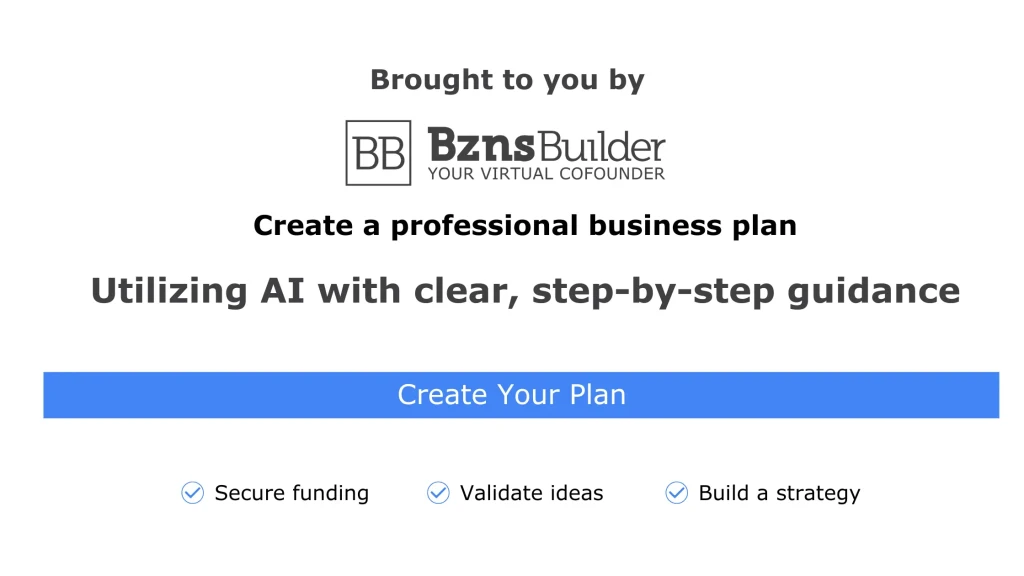Setting Small Business Goals: A Guide to Achieving Success

How happy are you with your business’s performance? Are you patting yourself on the back, having nailed every goal?
If the answer is no, you’re like many business owners who struggle to hit business targets. You know exactly what you want—a bigger business, larger per-customer sales, more leads, higher profits—but you struggle to meet your goals.
At BznsBuilder, we specialize in simplifying the goal-setting process for entrepreneurs in the EMEA region. With clear and actionable strategies, you can overcome these challenges and unlock your full potential. In this article, we’ll show you how to set effective business goals that drive success and keep your business thriving.
How to Set Achievable Business Goals
There is always so much to do when you’re a business owner. You need to find new clients, keep your existing clients happy, manage your finances, streamline your processes, and motivate your employees—all at the same time. It can feel overwhelming, but the key lies in focusing your efforts.
By sorting through the noise and setting clear priorities, you can identify goals that truly move the needle. This guide will help you cut through the clutter and establish business goals that are not only actionable but also impactful for long-term success. Let’s get started.
1. Clarify the Goals You’ll Prioritize
To ensure you don’t waste time and money, you must identify your top priorities when setting company goals for the year. These should address clear opportunities or challenges that have the greatest potential to grow your business.
So, how do you identify them?
A SWOT analysis provides a simple yet effective framework. By evaluating your business and competitors, you can pinpoint potential advantages and shortcomings that set you apart in the market. This is particularly useful in the diverse and competitive EMEA region, where understanding your unique strengths can make all the difference.
For established businesses, reviewing financial statements and forecasts offers additional insights. Ask yourself:
-
Where did you overperform or underperform?
-
Is your cash flow in line with expectations?
-
Are there any areas of overspending?
Answering these questions helps you understand your current financial position. From there, you can dig deeper into specific departments, initiatives, or line items to uncover opportunities worth tackling in the next year.
Example:
Imagine you operate a small e-commerce store specializing in handmade jewelry. During your review, you discover a concerning trend: a decline in repeat customers. Further analysis shows that while your initial customer acquisition has been strong, many customers are not returning for additional purchases. With this information, you might identify these focus areas:
-
Develop a customer loyalty program offering discounts or exclusive access to new collections to encourage repeat purchases. For instance, implementing a tiered rewards system could incentivize higher spending.
-
Enhance the post-purchase experience by improving packaging and offering personalized thank-you notes to build stronger customer connections. Additionally, sending follow-up emails with tailored product recommendations could further boost engagement and repeat purchases.
These focus areas are not yet goals but key priorities. Once you discuss them with your team (which we’ll cover next), you can transform them into SMART goals to ensure actionable progress.
2. Review These Goals with Your Team
Your team works closely with your products, services, and customers daily. They hold valuable insights into what’s working, what’s not, and what’s holding your business back. Leveraging their knowledge ensures you’re setting goals that address the most pressing issues and opportunities for your business.
After identifying your potential goals, involve your team in the review process. Organize a meeting where you present your proposed goals and encourage feedback. Team members might confirm your priorities or offer fresh perspectives that you hadn’t considered. For example, they may highlight specific operational bottlenecks or suggest innovative ways to improve customer engagement.
Involving your employees not only enhances the quality of your goals but also fosters a sense of ownership and engagement. When team members see their input valued, they’re more likely to align with and commit to achieving the goals.
Tip: Make the Discussion Interactive
-
Use visuals like charts or slides to present data supporting your goals.
-
Facilitate open discussions and actively listen to your team’s suggestions.
-
Highlight the link between their daily efforts and the broader objectives.
By engaging your team, you ensure that the goals you set are realistic, actionable, and supported by the people who will help achieve them. Next, we’ll explore how to transform these priorities into structured, actionable plans.
3. Make Your Goals SMART
You have identified two to three key business goals. Now it’s time to make them actionable. One of the most effective frameworks for doing this is setting SMART goals:
- Specific: What exactly are you going to do?
- Measurable: How will you know if you are succeeding?
- Achievable: How will you implement the goal?
- Relevant: Does the goal connect to your overall objectives?
- Timely: When will you achieve the goal by?
Let’s take one of our business goals and turn it into a SMART goal:
Original Idea: Increase client base by targeting local office workers.
Specific: Gain 20 new customers from the surrounding office buildings.
Measurable: Track progress by monitoring the number of new customers acquired and the profits generated while maintaining your existing customer base.
Achievable: Launch a customized sales promotion, publicized via leaflets and flyers distributed in the office buildings.
Relevant: This initiative will help grow your customer base and increase profitability, aligning with your broader business goals.
Timely: Achieve this goal by the end of Q2 2025.
By setting SMART goals, you ensure that each objective is well-defined and actionable, paving the way for measurable success. For instance, the handmade jewelry store can use this approach to transform its focus areas—such as customer loyalty programs—into specific, measurable, and time-bound initiatives. Next, we’ll delve into breaking down these goals into manageable steps for execution.
4. Set Key Performance Indicators (KPIs)
The SMART goal format provides a clear timeline and plan, but to truly track progress, you need to establish measurable indicators. Key Performance Indicators (KPIs) are numerical values that reflect whether your goal is within reach.
For example:
- Customer acquisition KPI: Track the number of new customers gained through a specific campaign.
- Sales growth KPI: Monitor monthly revenue increases to ensure you’re hitting your targets.
While creating SMART goals, define relevant KPIs that align with company and individual objectives. These metrics should provide actionable insights and keep your team focused on measurable outcomes. For instance, a handmade jewelry business might use KPIs like the percentage of repeat customers or average order value per sale.
By setting KPIs alongside your goals, you’ll be able to measure progress effectively and make data-driven adjustments as needed. For instance, the handmade jewelry store could track the percentage of repeat customers and the average order value to ensure its loyalty program and personalized marketing efforts are delivering results. Clear metrics like these will keep everyone on track and focused on achieving your business’s objectives.
5. Set a Structure to Review and Revise
If you want to make something happen, you need to create a schedule and build good habits around it.
Consider how you approach personal goals, like getting healthier. You wouldn’t just plan to exercise or eat better once. You’d make it part of your routine—exercising on specific days, planning meals in advance, and tracking your progress. Your business goals deserve the same level of commitment.
Schedule the actions you’ll take to reach your KPIs. For example, the handmade jewelry store could schedule monthly review meetings to evaluate the success of its loyalty program and track repeat customer rates. Adding regular (monthly or quarterly) business plan review meetings to your company calendar ensures you’ll revisit and refine your goals consistently. These reviews will help you assess progress, address challenges, and adjust your strategies as needed.
Tips for a Streamlined Review Process:
- Automate Reminders: Use calendar apps to set up recurring meetings and task management tools to organize deadlines and responsibilities.
- Prepare Data in Advance: Leverage tools like BznsBuilder to generate reports and track KPIs before the meeting.
- Encourage Collaboration: Involve key team members to gather diverse insights and foster alignment.
By incorporating regular reviews into your schedule, you can stay on track and ensure that your goals evolve alongside your business needs. Next, we’ll discuss how to celebrate successes and learn from setbacks to continually improve your business strategies.
The Importance of Setting Business Goals
Why are goals important? Here are a few reasons:
Goals Provide Clarity
As a business owner, you likely have countless tasks you want to accomplish. But which ones are most important? How do you know if you’re making progress?
Setting well-structured goals helps you prioritize your work, establish a clear direction, and provide a framework to measure success. By breaking down broad aspirations into specific, actionable steps, you create a roadmap that eliminates uncertainty and streamlines your efforts. No more random assignments or distractions—just a focused idea of what you want to achieve and the steps to get there.
For instance, instead of saying, “I want to grow my business,” you could set a goal like, “Increase monthly revenue by 15% within the next six months by expanding into a new market.” This clarity ensures everyone in your organization understands the target and how to contribute.
Goals Motivate and Align Your Team
Aimlessly taking on work rarely leads to success. Without a defined goal, there’s no beacon guiding your efforts or milestones to celebrate along the way.
Establishing company and team goals fosters greater motivation and engagement. Clear objectives inspire individuals to perform at their best because they see how their work impacts the overall mission. Moreover, it creates alignment across departments, ensuring everyone pulls in the same direction.
For example, a sales team with a goal to acquire 50 new clients in Q1 can collaborate with the marketing team, whose goal might be to generate 200 high-quality leads. This synergy drives productivity and boosts morale as employees see tangible results from their efforts.
Goals Provide a Structure to Measure Success
Goal-setting involves identifying the metrics you’ll use to gauge success. This upfront planning makes tracking progress more manageable and allows you to assess whether you’re still on course.
Skipping this process leaves your definition of success vague and directionless. You risk pursuing unproductive paths and might never fully realize your aspirations. Metrics such as revenue growth, customer retention rates, or production efficiency act as indicators of progress. Regularly reviewing these metrics allows you to make informed adjustments to strategies and stay focused on what truly matters.
For example, a goal to “improve customer satisfaction” could be measured through Net Promoter Scores (NPS) or customer feedback surveys, providing actionable data to refine your approach.
Goals Help Your Business Grow
Just as writing a business plan increases your chances of successfully launching a business, setting clear goals enhances your ability to achieve consistent growth. With well-structured objectives, you’ll know where you’re headed, how to get there, and whether you’re progressing.
By regularly setting, reviewing, and revising your goals, you can accelerate growth and avoid costly mistakes. Continuous goal-setting ensures you adapt to changes in the market, seize new opportunities, and stay ahead of competitors.
For example, a small e-commerce store might set quarterly goals such as “launch three new product lines” or “increase website traffic by 25%.” By breaking these objectives into actionable steps and monitoring progress, the business can maintain steady growth while staying responsive to customer needs.
A solid goal-setting practice not only keeps your business on track but also fosters innovation and resilience, positioning you for long-term success.
Types of Business Goals
The goal-setting process in this article focused primarily on long-term business performance goals—the kind you’ll set once a year. These broader goals may focus on any of the following:
Financial Goals
Financial goals are fundamental to achieving and maintaining a strong financial position. These may involve boosting revenue, optimizing costs, or enhancing profit margins. For example, a business might aim to increase net profit by 20% over the next fiscal year through strategic pricing and cost-cutting measures. Tracking cash flow, reducing unnecessary expenditures, or diversifying income streams are other effective approaches to solidify financial health.
Customer-Related Goals
Customer-related goals focus on enhancing the overall customer experience and growing the customer base. These could include improving customer retention rates by 25%, launching a loyalty program, or expanding services to new customer demographics. For instance, personalizing communication through targeted email campaigns or implementing AI-driven chat support can significantly improve customer satisfaction and repeat purchases.
Operational Goals
Operational goals are aimed at refining internal processes to boost efficiency and productivity. Businesses might focus on reducing product production times by 30%, automating manual workflows, or achieving a zero-error rate in quality checks. For instance, a manufacturing company could invest in advanced machinery to speed up production while maintaining quality, ensuring faster delivery times and reduced overheads.
Marketing and Sales Goals
These goals encompass expanding brand visibility and driving revenue growth through strategic marketing and sales initiatives. Examples include doubling social media engagement within six months, increasing conversion rates from digital campaigns by 10%, or launching a multi-channel marketing campaign to boost lead generation. A startup might use influencer partnerships and SEO strategies to significantly amplify brand awareness and drive traffic.
Employee and Team Goals
Employee and team goals focus on fostering a motivated, skilled, and cohesive workforce. Goals may include reducing turnover rates by 15%, increasing employee satisfaction scores by implementing regular feedback mechanisms, or providing leadership training for mid-level managers. Building a robust company culture through quarterly retreats or collaborative workshops can also create a more engaged and innovative team environment.
Sustainability and Social Responsibility Goals
Sustainability goals reflect a company’s commitment to ethical practices and environmental stewardship. Examples include reducing carbon emissions by 40%, eliminating non-recyclable packaging, or organizing community service programs. Companies adopting green technology in production or contributing a percentage of profits to social causes not only strengthen brand loyalty but also attract socially conscious customers.
Innovation and Development Goals
Innovation goals encourage businesses to explore new frontiers, such as launching a groundbreaking product, integrating advanced technology, or entering untapped markets. For example, a tech company might aim to develop an AI-powered app within 12 months or collaborate with research institutions to drive innovation. These goals keep businesses competitive and adaptable to industry trends.
Compliance and Risk Management Goals
These goals are essential for maintaining legal integrity and minimizing business risks. Ensuring compliance with data privacy regulations, conducting quarterly risk assessments, or creating a robust disaster recovery plan are examples of such goals. A company could also establish training sessions for employees to stay updated on evolving compliance standards, thereby safeguarding operations and reputation.
By aligning your business goals across these categories, you ensure a holistic strategy that fosters growth, resilience, and positive societal impact. Regularly reviewing and adapting these goals enables sustained progress and positions your business for long-term success.
Choosing the Right Goals is a Process
Selecting and setting the right goals for your business is not a task to be rushed. It requires careful consideration, strategic thinking, and a willingness to adapt as circumstances change. Even by following the steps in this article, there’s no absolute guarantee that the goals you initially choose will be the best fit for your business long-term.
Why the Review Process Matters
The importance of the review process cannot be overstated. Regularly revisiting your goals allows you to evaluate their relevance and effectiveness. If you find that a particular goal isn’t yielding the desired impact or aligning with your business’s evolving needs, you can recalibrate your efforts toward a more productive strategy. This level of adaptability ensures that your business stays focused and resilient in a constantly changing environment.
For instance, imagine setting a goal to increase sales through a new digital marketing campaign. Halfway through the year, metrics might reveal that the campaign isn’t driving sufficient traffic. A timely review would allow you to reallocate resources toward a strategy that yields better results, such as influencer collaborations or optimizing your e-commerce platform.
Goal Setting is Just the Beginning
While setting clear objectives is essential, it’s only the first step in building a successful business. Once goals are established, consider incorporating complementary strategies to strengthen your operations and navigate challenges effectively:
- Create a Comprehensive Business Strategy: Establish a detailed roadmap that outlines your vision, mission, and the actionable steps required to achieve both short- and long-term objectives. A well-crafted strategy ensures alignment across all levels of your organization.
- Build Resilience for Crisis Management: Equip your business to withstand unforeseen challenges by developing contingency plans and fostering operational flexibility. Whether it’s managing economic downturns or industry-specific disruptions, resilience is key to long-term survival.
- Prepare for Business Transitions: If selling your business is a future consideration, set preparatory goals to enhance its valuation. Streamlining processes, improving financial reporting, and solidifying customer relationships can make your business more attractive to potential buyers.
A Continuous Cycle of Improvement
Goal-setting is a dynamic process that requires regular reviews and updates. By combining thoughtful objectives with iterative improvements, you create a strong foundation for sustainable growth. Adaptability, strategic foresight, and disciplined execution will position your business not just to survive, but to thrive in the face of new opportunities and challenges.







